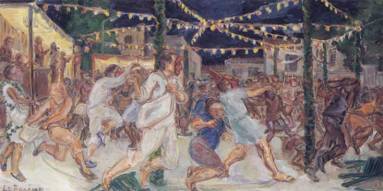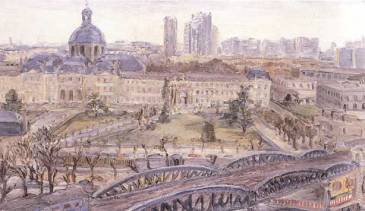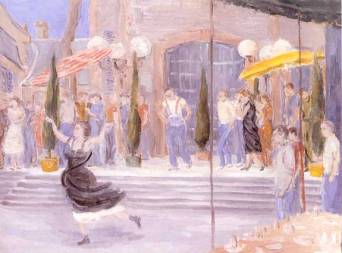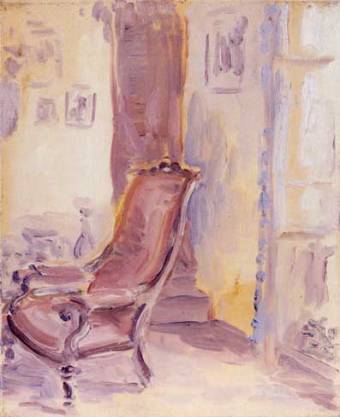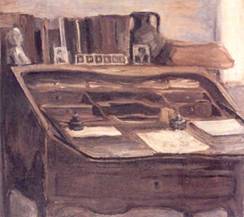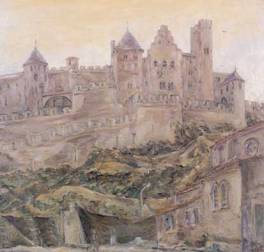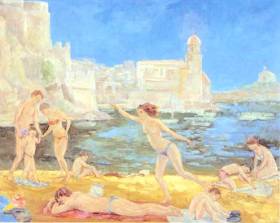|
The exhibition at Ranger’s House, Blackheath, London of Lessore’s French work ran from 9th July to 17th September 2000. For details on Ranger’s House visit their website. The earliest painting in the show was a little view of Antibes, painted in 1952 on his first visit to France. Most of the paintings were of the “Midi”. Since 1960, Lessore has stayed regularly in a house a few miles from Carcassonne. But there have also been fruitful trips to the coast, notably to Collioure, the village which attracted the “Fauves” and to Gruissan, a few miles from Béziers which is reputed among painters for having the most beautiful light in all France. In the north of France, there have been three main theatres of activity: the house known as “Kaymos”, Les Roches and Paris. ParisLessore lived in Paris in 1963 and 1964 and has made many visits since. In the 60s. he tended to paint landscapes from an old Ford van. It was, at that time, still relatively easy to park in Paris, and he did many street scenes on the spot. But there were other paintings, such as the views of the Salpétrière which were done from a window high up above the Boulevard de l’Hôpital or several of his sister-in-law’s flat in the Boulevard Masséna, near the Porte d’Italie, traditional point of departure for the Barbizon painters when leaving Paris for the forest of Fontainebleau and elsewhere. Lessore’s great-grandfather, the painter Emile Lessore, lived at Marlotte. This area, the “Ile de France”, is considered to have the best light in northern France. KaymosThis is a house outside the village of Foucherolles where the artist has stayed regularly since 1971. It is a traditional, stone and brick, single-storey farmhouse, in the flattish country south-east of Fontainebleau and a few miles north of Courtenay, a land of arable and dairy farms, oak woods, lakes and “miel du Gatinais”. Dotted about the plains, are villages of rough cream and honey-coloured stone, grey doors and shutters with red brick surrounds, and every loft has a gabled access in the front, often with a ladder permanently set up. Inside, the walls are lime-washed and the floors are rendered with a waxy lime mortar, or tiled. The people in the paintings are usually members of Lessore’s extended family. Les RochesSince 1970, the artist has stayed two or three times a year in this hamlet, close by Chézy-sur-Marne, (the etymology is the same as for cheese). Immaculate Champagne vineyards contrast with broad-leaved woods, steep-sided valleys, and clusters of brown-roofed cottages, the colour of the local “Brie”. Beyond is the endless windswept plain. Artists liked to come here in the past, but so, too, did invading armies, above all in the 1914-18 war, which is commemorated by massive military cemeteries and hills which still bear names such as “Côte 204”. And innumerable cellars carved into the rock slopes remind one of where the inhabitants sheltered during the bombardments. Below the hamlet, the clear Dolloir in its pebble bed, in former times “le ru d’Olloir”, flows through Chézy and into the grey-green Marne. Italy and ProvenceIn February 1962 Lessore went to Rome on a travelling scholarship and spent time in Florence, Arezzo, Urbino and various other places. Later that year, he lived in Villeneuve-lès-Avignon. It has been difficult to trace the owners of many paintings from either of these two periods. CarcassonneSince 1960, Lessore has stayed annually in a house some miles from this spectacular, largest fortified city in Europe. A natural fortress dominating the valley of the Aude, it was occupied, and progressively strengthened, by Greeks, Romans, Visigoths and Arabs, culminating in the 13th century additions of St. Louis, whose reign saw the end of the Albigensian wars, and who, having exiled its population in reprisal for their support for the Cathars, laid out for them the rectilinear “ville basse” which soon became, and still is, the important part of the town. Another remarkable local enterprise is the “Canal du Midi” built by Riquet in the 17th Century to link the Atlantic with the Mediterranean and in regular use by commercial barges until a few years ago. A series of artificial lakes was also constructed to feed it, the main one being that of St. Ferréol. The Paris meridian runs through the west side of Carcassonne. St. Ferréol, Collioure and GruissanSt. Ferréol is the largest of the artificial lakes created by Pierre Paul Riquet in the 17th century to feed the “Canal du Midi” with which he linked the Atlantic to the Mediterranean. It has been one of the artist’s regular visiting places since 1960. Lessore first visited Collioure in 1965, at which time it was still visibly a small fishing port, surrounded by wild hills and not very different from the town that the Fauves knew and loved. Since then, it has been so developed for tourism, that fishing boats are not even allowed in the harbour in the summer months. Tourists come, for their week or fortnight, and, finding little to do apart from bathing and lying on the beach, walk endlessly to and fro along the promenade. It was the spectacle of this desperate boredom which sparked off the paintings. Gruissan, near Narbonne, is also a small fishing port, but the pictures in this exhibition are of the long sandy beach of Gruissan Plage to the north east where families spend the day burning in the sun and cooling off in the sea. |
